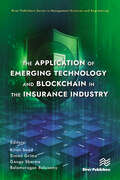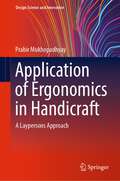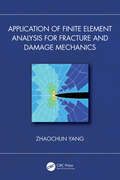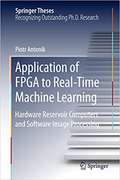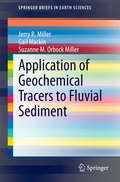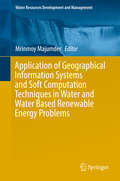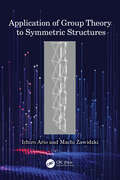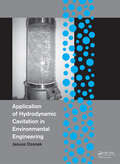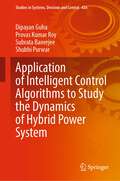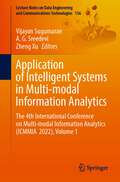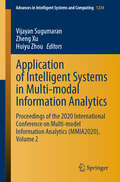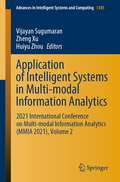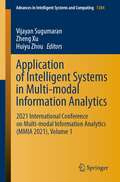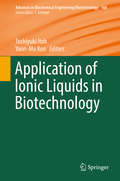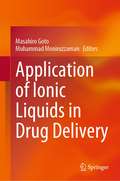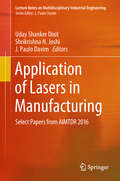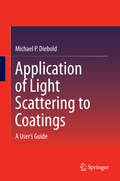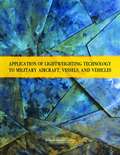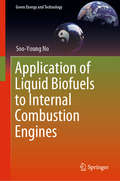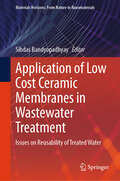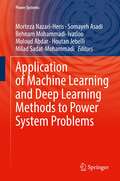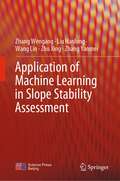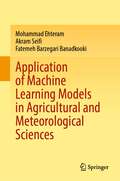- Table View
- List View
The Application of Emerging Technology and Blockchain in the Insurance Industry (River Publishers Series in Management Sciences and Engineering)
by Kiran Sood Simon Grima Ganga Sharma Balamurugan BalusamyThis book is a unique guide to the disruptions, innovations, and opportunities that technology provides the insurance sector and acts as an academic/industry-specific guide for creating operational effectiveness, managing risk, improving financials, and retaining customers. It also contains the current philosophy and actionable strategies from a wide range of contributors who are experts on the topic. It logically explains why traditional ways of doing business will soon become irrelevant and therefore provides an alternative choice by embracing technology. Practitioners and students alike will find value in the support for understanding practical implications of how technology has brought innovation and modern methods to measure, control, and evaluation price risk in the insurance business. It will help insurers reduce operational costs, strengthen customer interactions, target potential customers to provide usage-based insurance, and optimize the overall business. Retailers and industry giants have made significant strides in adopting digital platforms to deliver a satisfying customer experience. Insurance companies must adjust their business models and strategies to remain competitive and take advantage of technology. Insurance companies are increasingly investing in IT and related technologies to improve customer experience and reduce operational costs. Innovation through new technologies is a key driver of change in the financial sector which is often accompanied by uncertainty and doubt. This book will play a pivotal role in risk management through fraud detection, regulatory compliances, and claim settlement leading to overall satisfaction of customers.
Application of Ergonomics in Handicraft: A Laypersons Approach (Design Science and Innovation)
by Prabir MukhopadhyayThis book is about the application of ergonomics in handicraft manufacturing and design keeping in mind the two sets of users, craftsmen and customers buying handicraft items. Written in an easy to understand language and in a story telling format. It requires no prior knowledge of the subject nor any knowledge of science or technology for using this book and applying it in handicraft manufacturing and design. The book starts with an overview of the application of ergonomics in different aspects of craft manufacturing, touching upon tools, space, process and then moves into the aspects of ergonomics of craft packaging and displaying. Alongside the book also explains the ergonomic aspects of designing of handicraft products keeping the users of the products in mind, their dimensions, capacity, limitations etc. Each chapter starts with an "overview" and ends with "key points" and exercises to help the readers in applying the principles of ergonomics in handicraft. The last chapter is dedicated to exercises in different areas of handicraft and the ergonomic applications for them, followed by ergonomic design directions to solve them.
Application of Finite Element Analysis for Fracture and Damage Mechanics
by Zhaochun YangApplication of Finite Element Analysis for Fracture and Damage Mechanics focuses on the finite element analysis of various material models and their relevant fracture and damage models using this advanced software. The book consists of three parts: Part I introduces the various material models, Part II highlights the finite element modeling of their relevant fracture parameters, and Part III deals with various material damage models. Each part begins with a simple problem with theoretical results compared with finite element results to help readers understand the numerical simulation results. Discusses material models such as composite, elastic, elastoplastic, and creep models Covers fracture parameters like K, J, C*, and VCCT Presents relevant material damage models (ductile, creep, and composite) Explores typical and complex problems, including the inclined crack model, penny shaped crack model, compact tension specimen, end-loaded split (ELS) model, double cantilever beam (DCB) model, and notched model Includes all modeling files, such as APDL input files, Python code and creep damage subroutine, in the appendixes Written for materials and mechanical engineers, this text addresses and provides solutions to the real-life engineering challenge of damage and fracture in materials and structures.
Application of FPGA to Real‐Time Machine Learning: Hardware Reservoir Computers And Software Image Processing (Springer Theses)
by Piotr AntonikNominated as an outstanding Ph.D. thesis by the Université libre de Bruxelles, Belgium.<p><p> Provides a thorough introduction to reservoir computing and field-programmable gate arrays Discusses the problems encountered on the path to the results discussed Uses an engaging and lively writing style.<p> This book lies at the interface of machine learning – a subfield of computer science that develops algorithms for challenging tasks such as shape or image recognition, where traditional algorithms fail – and photonics – the physical science of light, which underlies many of the optical communications technologies used in our information society. It provides a thorough introduction to reservoir computing and field-programmable gate arrays (FPGAs).<p> Recently, photonic implementations of reservoir computing (a machine learning algorithm based on artificial neural networks) have made a breakthrough in optical computing possible. In this book, the author pushes the performance of these systems significantly beyond what was achieved before. By interfacing a photonic reservoir computer with a high-speed electronic device (an FPGA), the author successfully interacts with the reservoir computer in real time, allowing him to considerably expand its capabilities and range of possible applications. Furthermore, the author draws on his expertise in machine learning and FPGA programming to make progress on a very different problem, namely the real-time image analysis of optical coherence tomography for atherosclerotic arteries.
Application of Geochemical Tracers to Fluvial Sediment (SpringerBriefs in Earth Sciences)
by Jerry R. Miller Gail Mackin Suzanne M. Orbock MillerThis book takes an in-depth look at the theory and methods inherent in the tracing of riverine sediments. Examined tracers include multi-elemental concentration data, fallout radionuclides (e. g. , 210Pb, 137Cs, 7Be), radiogenic isotopes (particularly those of Pb, Sr, and Nd), and novel ("non-traditional") stable isotopes (e. g. , Cd, Cu, Hg, and Zn), the latter of which owe their application to recent advances in analytical chemistry. The intended goal is not to replace more 'traditional' analyses of the riverine sediment system, but to show how tracer/fingerprinting studies can be used to gain insights into system functions that would not otherwise be possible. The text, then, provides researchers and catchment managers with a summary of the strengths and limitations of the examined techniques in terms of their temporal and spatial resolution, data requirements, and the uncertainties in the generated results. The use of environmental tracers has increased significantly during the past decade because it has become clear that documentation of sediment and sediment-associated contaminant provenance and dispersal is essential to mitigate their potentially harmful effects on aquatic ecosystems. Moreover, the use of monitoring programs to determine the source of sediments to a water body has proven to be a costly, labor intensive, long-term process with a spatial resolution that is limited by the number of monitoring sites that can be effectively maintained. Alternative approaches, including the identification and analysis of eroded upland areas and the use of distributed modeling routines also have proven problematic. The application of tracers within riverine environments has evolved such that they focus on sediments from two general sources: upland areas and specific, localized, anthropogenic point sources. Of particular importance to the former is the development of geochemical fingerprinting methods that quantify sediment provenance (and to a much lesser degree, sediment-associated contaminants) at the catchment scale. These methods have largely developed independently of the use of tracers to document the source and dispersal pathways of contaminated particles from point-sources of anthropogenic pollution at the reach- to river corridor-scale. Future studies are likely to begin merging the strengths of both approaches while relying on multiple tracer types to address management and regulatory issues, particularly within the context of the rapidly developing field of environmental forensics.
Application of Geographical Information Systems and Soft Computation Techniques in Water and Water Based Renewable Energy Problems (Water Resources Development and Management)
by Mrinmoy MajumderThis book highlights the application of Geographical Information System (GIS) and nature based algorithms to solve the problems of water and water based renewable energy resources. The irregularity in availability of resources and inefficiency in utilization of the available resources has reduced the potentiality of water and water based renewable energy resources. In recent years various soft computation methods (SCM) along with GIS were adopted to solve critical problems. The book collects various studies where many SCMs were used along with GIS to provide a solution for optimal utilization of natural resources for satisfying the basic needs of the population as well as fulfilling their burgeoning energy demands. The articles depict innovative application of soft computation techniques to identify the root cause and to mitigate the uncertainty for optimal utilization of the available water resources. The advantage of SCM and GIS were used to maximize the utilization of water resources under cost and time constraints in face of climatic abnormalities and effect of rapid urbanization.
Application of Group Theory to Symmetric Structures
by Ichiro Ario Machi ZawidzkiArio and Zawidzki show readers how to handle symmetric structures in engineering using group-theoretic bifurcation theory as a mathematical tool for the finite element analysis of symmetric structures.They guide the reader from the initial mathematical concepts through to application examples. Readers will gain a solid theoretical grounding in group theory and strong working knowledge of the use of computational frameworks for structural analysis using mathematical representations of symmetry and physical symmetry. First, the authors elaborate an outline of symmetric structures in engineering and then describe the representation of symmetry and group theory. They then discuss block diagonalization theory and finite element analysis models. This provides readers with the base knowledge needed for Chapter 6, which is based on numerical analysis examples of invariant, static FEM model systems and dynamic model systems of the dihedral group. This unique approach is a vital method that will enable readers to reduce the time and computation needed for accurate analysis so that they can better design such structures. The focus on finite element methods and practical examples and case studies throughout provides a strong practical foundation for anyone studying or working in this field.The book is a valuable resource for undergraduate and postgraduate students on various courses such as civil and mechanical engineering, architecture, structural engineering, applied mathematics, and physics. Additionally, it describes vital practical solutions for structural engineers, structural system manufacturers, fabricators of prefabricated elements, and developers of computational mechanics and so on.
Application of Hydrodynamic Cavitation in Environmental Engineering
by Janusz OzonekContaining the state-of-the-art in hydrodynamic cavitation, the book consists of two parts. The first part presents the physical basis of cavitation and a systematic classification of various kinds of cavitation and their formation sources. Special attention is paid to a group of factors that promote cavitation formation in natural liquids. A gener
Application of Intelligent Control Algorithms to Study the Dynamics of Hybrid Power System (Studies in Systems, Decision and Control #426)
by Dipayan Guha Provas Kumar Roy Subrata Banerjee Shubhi PurwarThis book aims to systematically review and design different intelligent control algorithms for the small-signal stability assessment of HPS. With the growing consciousness of global warming and the fast depletion of natural power generation resources, the existing power system is on the verge of transitions to a “hybrid power system (HPS)” integrated with distributed energy resources. The recent results and requirements for the developments of intelligent control algorithms have motivated the authors to introduce this book for extensively analyzing the performance of HPS against unknown/uncertain disturbances. This book introduces fractional-order resilient control methodologies for arresting small-signal instability of HPS. The prospective investigation has been performed on the MATLAB platform. This book is helpful for undergraduate, postgraduate students, and research scholars working in power system stability, control applications, and soft computing in particular.
Application of Intelligent Systems in Multi-modal Information Analytics: The 4th International Conference on Multi-modal Information Analytics (ICMMIA 2022), Volume 1 (Lecture Notes on Data Engineering and Communications Technologies #136)
by Vijayan Sugumaran A. G. Sreedevi Zheng XuThis book provides comprehensive coverage of the latest advances and trends in information technology, science, and engineering. Specifically, it addresses a number of broad themes, including multimodal informatics, data mining, agent-based and multi-agent systems for health and education informatics, which inspire the development of intelligent information technologies. The contributions cover a wide range of topics such as AI applications and innovations in health and education informatics; data and knowledge management; multimodal application management; and web/social media mining for multimodal informatics. Outlining promising future research directions, the book is a valuable resource for students, researchers, and professionals and a useful reference guide for newcomers to the field. This book is a compilation of the papers presented in the 4th International Conference on Multi-modal Information Analytics, held online, on April 23, 2022.
Application of Intelligent Systems in Multi-modal Information Analytics: The 4th International Conference on Multi-modal Information Analytics (ICMMIA 2022), Volume 2 (Lecture Notes on Data Engineering and Communications Technologies #138)
by Vijayan Sugumaran A. G. Sreedevi Zheng XuThis book provides comprehensive coverage of the latest advances and trends in information technology, science and engineering. Specifically, it addresses a number of broad themes, including multi-modal informatics, data mining, agent-based and multi-agent systems for health and education informatics, which inspire the development of intelligent information technologies. The book covers a wide range of topics such as AI applications and innovations in health and education informatics; data and knowledge management; multi-modal application management; and web/social media mining for multi-modal informatics. Outlining promising future research directions, the book is a valuable resource for students, researchers and professionals and a useful reference guide for newcomers to the field. This book is a compilation of the papers presented in the 4th International Conference on Multi-modal Information Analytics, held online, on April 23, 2022.
Application of Intelligent Systems in Multi-modal Information Analytics: Proceedings of the 2020 International Conference on Multi-model Information Analytics (MMIA2020), Volume 1 (Advances in Intelligent Systems and Computing #1233)
by Vijayan Sugumaran Zheng Xu Huiyu ZhouThis book presents the proceedings of the 2020 International Conference on Intelligent Systems Applications in Multi-modal Information Analytics, held in Changzhou, China, on June 18–19, 2020. It provides comprehensive coverage of the latest advances and trends in information technology, science and engineering. It addresses a number of broad themes, including data mining, multi-modal informatics, agent-based and multi-agent systems for health and education informatics, which inspire the development of intelligent information technologies. The contributions cover a wide range of topics such as AI applications and innovations in health and education informatics; data and knowledge management; multi-modal application management; and web/social media mining for multi-modal informatics. Outlining promising future research directions, the book is a valuable resource for students, researchers and professionals, and a useful reference guide for newcomers to the field.
Application of Intelligent Systems in Multi-modal Information Analytics: Proceedings of the 2020 International Conference on Multi-model Information Analytics (MMIA2020), Volume 2 (Advances in Intelligent Systems and Computing #1234)
by Vijayan Sugumaran Zheng Xu Huiyu ZhouThis book presents the proceedings of the 2020 International Conference on Intelligent Systems Applications in Multi-modal Information Analytics, held in Changzhou, China, on June 18–19, 2020. It provides comprehensive coverage of the latest advances and trends in information technology, science and engineering. It addresses a number of broad themes, including data mining, multi-modal informatics, agent-based and multi-agent systems for health and education informatics, which inspire the development of intelligent information technologies. The contributions cover a wide range of topics such as AI applications and innovations in health and education informatics; data and knowledge management; multi-modal application management; and web/social media mining for multi-modal informatics. Outlining promising future research directions, the book is a valuable resource for students, researchers and professionals, and a useful reference guide for newcomers to the field.
Application of Intelligent Systems in Multi-modal Information Analytics: 2021 International Conference on Multi-modal Information Analytics (MMIA 2021), Volume 2 (Advances in Intelligent Systems and Computing #1385)
by Vijayan Sugumaran Zheng Xu Huiyu ZhouThis book provides comprehensive coverage of the latest advances and trends in information technology, science and engineering. Specifically, it addresses a number of broad themes, including multi-modal informatics, data mining, agent-based and multi-agent systems for health and education informatics, which inspire the development of intelligent information technologies. The contributions cover a wide range of topics such as AI applications and innovations in health and education informatics; data and knowledge management; multi-modal application management; and web/social media mining for multi-modal informatics. Outlining promising future research directions, the book is a valuable resource for students, researchers and professionals, and a useful reference guide for newcomers to the field. This book is a compilation of the papers presented in the 2021 International Conference on Multi-modal Information Analytics, held in Huhehaote, China, on April 23–24, 2021.
Application of Intelligent Systems in Multi-modal Information Analytics: 2021 International Conference on Multi-modal Information Analytics (MMIA 2021), Volume 1 (Advances in Intelligent Systems and Computing #1384)
by Vijayan Sugumaran Zheng Xu Huiyu ZhouThis book provides comprehensive coverage of the latest advances and trends in information technology, science and engineering. Specifically, it addresses a number of broad themes, including multi-modal informatics, data mining, agent-based and multi-agent systems for health and education informatics, which inspire the development of intelligent information technologies. The contributions cover a wide range of topics such as AI applications and innovations in health and education informatics; data and knowledge management; multi-modal application management; and web/social media mining for multi-modal informatics. Outlining promising future research directions, the book is a valuable resource for students, researchers and professionals, and a useful reference guide for newcomers to the field. This book is a compilation of the papers presented in the 2021 International Conference on Multi-modal Information Analytics, held in Huhehaote, China, on April 23–24, 2021.
Application of Ionic Liquids in Biotechnology (Advances in Biochemical Engineering/Biotechnology #168)
by Toshiyuki Itoh Yoon-Mo KooThis volume explores how ionic liquids are used in different areas of biotechnology. It also provides insights on the interaction of ionic liquids with biomolecules and biomaterials. Ionic liquids have become essential players in the fields of synthesis, catalysis, extraction and electrochemistry, and their unique properties have opened a wide range of applications in biotechnology. Readers will discover diverse examples of the application of ionic liquids as solvents for biomaterials extraction and pretreatment, in enzymatic and whole cell catalysed reaction, and as activation agents for biocatalysis. Particular attention is given to the biologically functionalized ionic liquids employed in medical and pharmaceutical applications. Although ionic liquids are considered “green solvents”, the contributing authors will also explore their environmental impact when applied to biotechnology. Chemical, biological and medical scientists interested in ionic liquids and biotechnology will find this work instructive and informative.
Application of Ionic Liquids in Drug Delivery
by Masahiro Goto Muhammad MoniruzzamanThis book presents recent advances in the use of ionic liquids in medicine and pharmaceutics with particular emphasis on addressing critical pharmaceutical challenges, including the low solubility, polymorphism, and bioavailability of drugs. It also provides insights into the development of the biologically functionalized ionic liquids suitable for medical and pharmaceutical applications. Ionic liquids have been used as potential solvents or materials in the fields of pharmaceutical drug delivery and formulations because of their unique and tunable physicochemical and biological properties. Readers find explanations of the diverse approaches to the application of ionic liquids in drug solubility, active pharmaceutical ingredient (API) formulation, and drug delivery systems, such as topical, transdermal, and oral delivery, with particular emphasis on recent developments. Particular attention is given to the development of ionic liquid-assisted effective drug delivery techniques for sparingly soluble or insoluble drug molecules. This book also discusses the biological activities of ionic liquids for possible applications in drug formulation and drug delivery systems. Scientists in disciplines such as chemistry, biology, and pharmaceutics find this book instructive and informative for developing ionic liquid-based drug formulations or drug delivery systems.
Application of Lasers in Manufacturing: Select Papers From Aimtdr 2016 (Lecture Notes on Multidisciplinary Industrial Engineering)
by J. Paulo Davim Shrikrishna N. Joshi Uday Shanker DixitThis book mainly addresses the applications of lasers in the manufacture of various industrial components. The technologies presented here have scopes of application ranging from the macro to meso and micro level of components and features. This book includes chapters on the basic and advanced applications of lasers in the manufacturing domain. They present theoretical and practical aspects of laser technology for various applications such as laser-based machining, micro-scribing, texturing, machining of micro-sized channels; laser welding; laser-based correction of sheet metal, i.e. straightening; laser forming; and laser technology for 3-D printing. Lasers have various applications such as the production of powerful lights for illumination or decoration; measurement of velocity (transportation) and length; interferometry; printing; recording; communication; bio-medical instrumentation and pollution detection. A significant body of literature is available on the physics of lasers and types of lasers. However it has been noted there are a few books published on the “applications of lasers in manufacturing domain,” a gap that this book remedies. Gathering contributions by leading engineers and academicians in this area, it offers a valuable source of information for young scientists and research students.
Application of Light Scattering to Coatings: A User’s Guide
by Michael P. DieboldThe book begins with the fundamentals of light scattering, first by individual particles, then by small groups of particles, and finally by the trillions of particles present in a real-life paint film. From there, Dr. Diebold focuses on application of these fundamentals to paint formulation. The scope includes both theory and practice with an emphasis on application (from both performance and cost standpoints). The book gives a clear understanding of light scattering principles and application of these principles to paint formulation (with a focus on TiO2 - the strongest scattering material available to paint formulators). The reader will be in a position to formulate and reformulate paints for maximum cost effectiveness. Application of Light Scattering to Coatings: A Users Guide is ideal for a range of professions working in paint formulation and manufacturing. This book also: Distills difficult theories (light scattering, paint formulation) into easy-to-understand concepts Adopts a qualitative perspective, with minimal use of complex equations, making key scientific concepts accessible to all paint formulators without a prerequisite of higher mathematics Offers an accessible resource for formulators new to the field while maintaining a high degree of relevance to experienced coating formulators Discusses the interplay between resin, TiO2 pigments, and paint extenders with regard to paint performance and cost Presents an unbiased assessment of opacifying potential of TiO2 alternatives Outlines strategies for minimizing overall costs of paints.
Application of Lightweighting Technology to Military Vehicles, Vessels, and Aircraft
by National Materials and Manufacturing Board Division on Engineering and Physical Sciences Committee on Benchmarking the Technology and Application of Lightweighting National Research CouncilLightweighting is a concept well known to structural designers and engineers in all applications areas, from laptops to bicycles to automobiles to buildings and airplanes. Reducing the weight of structures can provide many advantages, including increased energy efficiency, better design, improved usability, and better coupling with new, multifunctional features. While lightweighting is a challenge in commercial structures, the special demands of military vehicles for survivability, maneuverability and transportability significantly stress the already complex process. Application of Lightweighting Technology to Military Vehicles, Vessels, and Aircraft assesses the current state of lightweighting implementation in land, sea, and air vehicles and recommends ways to improve the use of lightweight materials and solutions. This book considers both lightweight materials and lightweight design; the availability of lightweight materials from domestic manufacturers; and the performance of lightweight materials and their manufacturing technologies. It also considers the "trade space"--that is, the effect that use of lightweight materials or technologies can have on the performance and function of all vehicle systems and components. This book also discusses manufacturing capabilities and affordable manufacturing technology to facilitate lightweighting. Application of Lightweighting Technology to Military Vehicles, Vessels, and Aircraft will be of interest to the military, manufacturers and designers of military equipment, and decision makers.
Application of Liquid Biofuels to Internal Combustion Engines (Green Energy and Technology)
by Soo-Young NoThis book provides a comprehensive overview of the application of liquid biofuels to internal combustion (IC) engines. Biofuels are one of the most promising renewable and sustainable energy sources. Particularly, liquid biofuels obtained from biomass could become a valid alternative to the use of fossil fuels in the light of increasingly stringent environmental constraints. In this book, the discussion is limited to liquid biofuels obtained from triglycerides and lignocellulose among the many different kinds of biomass. Several liquid biofuels from triglycerides, straight vegetable oil, biodiesel produced from inedible vegetable oil, hydrotreated vegetable oil, and pyrolytic oil have been selected for discussion, as well as biofuels from lignocellulose bio-oil, alcohols such as methanol, ethanol and butanol, and biomass-to-liquids diesel. This book includes three chapters on the application of methanol, ethanol and butanol to advanced compression ignition (CI) engines such as LTC, HCCI, RCCI and DF modes. Further, the application of other higher alcohols and other drop-in fuels such as DMF, MF, MTHF, and GVL are also discussed. The book will be a valuable resource for graduate students, researchers and engine designers who are interested in the application of alcohols and other biofuels in advanced CI engines, and also useful for alternative energy planners selecting biofuels for CI engines in the future.
Application of Low Cost Ceramic Membranes in Wastewater Treatment: Issues on Reusability of Treated Water (Materials Horizons: From Nature to Nanomaterials)
by Sibdas BandyopadhyayThis book reviews the status of developing tailor-made low-cost membranes and membrane-based separation processes for applications in wastewater treatment. It also presents an overview of industry-specific case studies upholding the waste-to-resource strategy for utilization of low-cost ceramic membranes in industrial wastewater treatment. This book highlights methods, results, and examples demonstrating that low-cost ceramic membranes possess similar features and advantages comparable to the commercially available ceramic membranes, thereby minimizing the prohibitive cost of their usage in wastewater treatment. Thus, the readers who are looking for more economical alternatives for wastewater treatment can be introduced with the cheaper membrane materials. It also discusses the selection and method of application of such membranes in the treatment processes. This book can serve as a valuable reference for researchers and professionals interested in wastewater treatment and allied fields.
Application of Machine Learning and Deep Learning Methods to Power System Problems (Power Systems)
by Behnam Mohammadi-Ivatloo Morteza Nazari-Heris Somayeh Asadi Moloud Abdar Houtan Jebelli Milad Sadat-MohammadiThis book evaluates the role of innovative machine learning and deep learning methods in dealing with power system issues, concentrating on recent developments and advances that improve planning, operation, and control of power systems. Cutting-edge case studies from around the world consider prediction, classification, clustering, and fault/event detection in power systems, providing effective and promising solutions for many novel challenges faced by power system operators. Written by leading experts, the book will be an ideal resource for researchers and engineers working in the electrical power engineering and power system planning communities, as well as students in advanced graduate-level courses.
Application of Machine Learning in Slope Stability Assessment
by Zhang Wengang Liu Hanlong Wang Lin Zhu Xing Zhang YanmeiThis book focuses on the application of machine learning in slope stability assessment. The contents include: overview of machine learning approaches, the mainstream smart in-situ monitoring techniques, the applications of the main machine learning algorithms, including the supervised learning, unsupervised learning, semi- supervised learning, reinforcement learning, deep learning, ensemble learning, etc., in slope engineering and landslide prevention, introduction of the smart in-situ monitoring and slope stability assessment based on two well-documented case histories, the prediction of slope stability using ensemble learning techniques, the application of Long Short-Term Memory Neural Network and Prophet Algorithm in Slope Displacement Prediction, displacement prediction of Jiuxianping landslide using gated recurrent unit (GRU) networks, seismic stability analysis of slopes subjected to water level changes using gradient boosting algorithms, efficient reliability analysis of slopes in spatially variable soils using XGBoost, efficient time-variant reliability analysis of Bazimen landslide in the Three Gorges Reservoir Area using XGBoost and LightGBM algorithms, as well as the future work recommendation.The authors also provided their own thoughts learnt from these applications as well as work ongoing and future recommendations.
Application of Machine Learning Models in Agricultural and Meteorological Sciences
by Mohammad Ehteram Akram Seifi Fatemeh Barzegari BanadkookiThis book is a comprehensive guide for agricultural and meteorological predictions. It presents advanced models for predicting target variables. The different details and conceptions in the modelling process are explained in this book. The models of the current book help better agriculture and irrigation management. The models of the current book are valuable for meteorological organizations. Meteorological and agricultural variables can be accurately estimated with this book's advanced models. Modelers, researchers, farmers, students, and scholars can use the new optimization algorithms and evolutionary machine learning to better plan and manage agriculture fields. Water companies and universities can use this book to develop agricultural and meteorological sciences. The details of the modeling process are explained in this book for modelers. Also this book introduces new and advanced models for predicting hydrological variables. Predicting hydrological variables help water resource planning and management. These models can monitor droughts to avoid water shortage. And this contents can be related to SDG6, clean water and sanitation. The book explains how modelers use evolutionary algorithms to develop machine learning models. The book presents the uncertainty concept in the modeling process. New methods are presented for comparing machine learning models in this book. Models presented in this book can be applied in different fields. Effective strategies are presented for agricultural and water management. The models presented in the book can be applied worldwide and used in any region of the world. The models of the current books are new and advanced. Also, the new optimization algorithms of the current book can be used for solving different and complex problems. This book can be used as a comprehensive handbook in the agricultural and meteorological sciences. This book explains the different levels of the modeling process for scholars.
